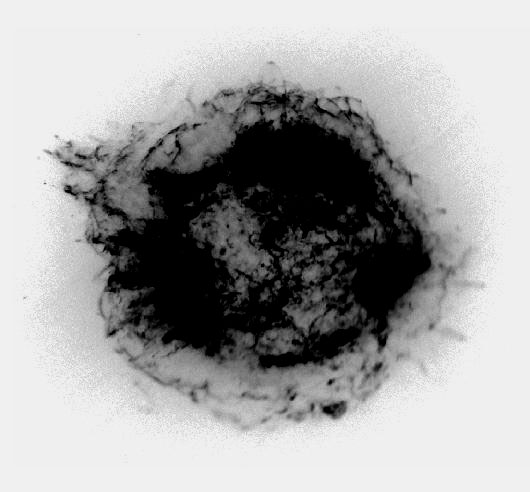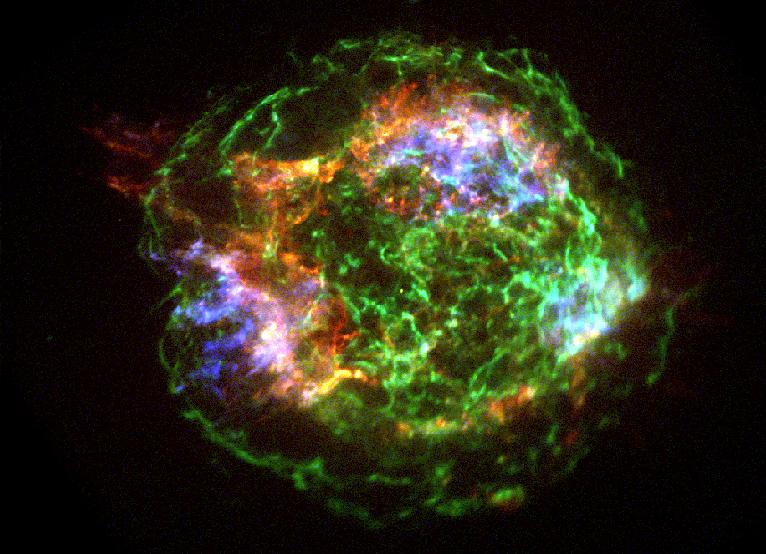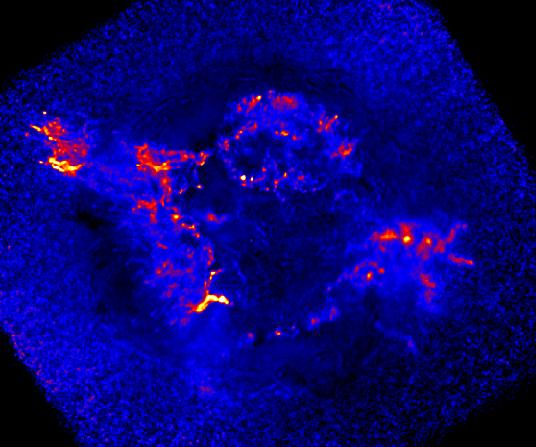

The Chandra project decided in July 2004 to postpone indefinitely the bakeout of the ACIS instrument which had been tentatively scheduled for September 2004. There are two reasons for the postponement. The proposed bakeout intended to use additional heaters on the Science Instrument Module (SIM) to heat the ACIS aperture in the SIM and the top of the ACIS collimator to improve the effectiveness of the bakeout. A safety review of the use of these heaters revealed a concern that the heaters may not work as expected and may pose a threat to the other heaters on that circuit. The heaters in question were designed to be used on the first day of the mission in case the shuttle needed to return to earth with Chandra in the payload bay. They have not been used since the first day of the mission, but some of the other heaters on the circuit are used during normal operations. Second, further analysis of the rate at which the contaminant(s) have built up in the centers and edges of the Optical Blocking Filters (OBFs) indicates that the contaminant(s) might be less volatile than what was assumed in the simulations of the bakeout.
The Chandra project, led by the Project Science team at MSFC, has been simulating the effects of the bakeout without the additional heaters on the SIM and with different assumed volatilities for the contaminant(s). The project is evaluating the results of these simulations in order to decide if the outcome of the bakeout is likely to be positive. In addition, the ACIS team is planning additional irradiation tests on the ground to understand better the implications of a bakeout for the CCDs' performance.
The Chandra project will continue to investigate the feasibility of a bakeout of the ACIS instrument. At this time it is impossible to predict if this effort will result in a decision to bakeout the instrument.
Paul Plucinsky
The most recent of the known supernova explosions in our Galaxy occurred more than 330 years ago in the constellation Cassiopeia. It was apparently so dim that it went unnoticed at the time, but since then, its remnant Cassiopeia A has become one of the best-observed astronomical objects at all wavelengths. Last spring, the Chandra Observatory took a 1 million-second look at Cas A with ACIS--the deepest X-ray view ever taken of this or any other supernova remnant.
This mammoth observation was executed in 9 OBSIDs between 14 April and 5 May 2004, except for a "short" 50 ks segment completed earlier in the year on 8 February. The observation produced approximately 300 million X-ray photons, most of which are shown in Figure 5. Three energy-selected images are color-coded and overlaid in Figure 6 to illustrate the remnant’s distinct morphologies at different energies (Si He a in red, Fe Ka in blue, and 4-6 keV in green).
The deep Cas A observation makes the spectra of Cas A's fine knots, filaments, and diffuse emission accessible at or near Chandra's angular resolution throughout the remnant. The knots and filaments are important keys to understanding the explosion that produced Cas A because most of them are glowing in X-ray emission from shock-heated ejecta. Moreover, their spectra are dominated by the very elements, Si and Fe, that are formed nearest the core of the star during the supernova explosion. Though theorists have been coming closer and closer to generating core-collapse explosions on their computers, successful simulated explosions have generally been elusive so far, and the actual mechanism or mechanisms of core-collapse remains incompletely understood. Though it is not likely that Cas A was a "typical" core-collapse explosion (if one even exists), it is a key target for studying core-collapse explosions because its central debris are much more accessible to us than in any other remnant.
Cas A and ChandraFrom its beginnings, Chandra has been associated with Cas A, which was its first light target. That 5 ks snapshot immediately gave us a revolutionary new view of Cas A. First, it revealed the presence of a faint, bare, compact remnant near Cas A's center (Tananbaum et al. 1999). It was expected to exist because Cas A shows fast O-rich ejecta filaments that point to a core-collapse origin, but had not been previously detected. It had remained elusive until Chandra because it is faint and compact, rather than being a classical Crab-like pulsar surrounded by a bright synchrotron wind nebula. Chandra has since uncovered a number of other examples of faint, quiet neutron stars in supernova remnants (e.g., Kaspi et al. 2004). Chandra first light also showed that Fe ejecta in Cas A are located out beyond the Si ejecta at large radii in the southeast (Hughes et al. 2000; also see Figure 6), implying that the explosion was a turbulent one. The Fe was formed in the hottest regions of the ejecta during the explosion, (i.e., just outside the neutron star) but now, at least some of the Fe is found out beyond elements ranging from O to Si to Ca, that were presumably formed in layers above the Fe. Further studies with XMM-Newton have confirmed that the Fe Doppler velocities in Cas A generally exceed those of Si even where the Fe and Si are projected to the same apparent radius (Willingale et al. 2002). This indicates that the Si-Fe turbulent overturn is widespread in Cas A.
Knots with a highly enhanced Fe composition are readily identified in the southeastern region of Cas A. These must have been produced by complete Si-burning, possibly with a- rich freezeout (when expansion at low densities quenches the nucleosynthesis in the presence of excess a particles). The primary product is 56Ni decaying to 56Fe, along with trace amounts of radioactive 44Ti. In hard X-rays and g-rays, the 44Ti by-product of this process is also observed through the nuclear de-excitation lines of its decay products (Iyudin et al. 1994, Vink et al. 2001), but cannot be localized within the remnant. By modelling the hydrodynamics and plasma physics in conjuction with the Chandra spectra (Laming & Hwang 2003), it is inferred that the Fe is mixed outwards roughly to the position of ejecta at the Si-O boundary layer in the pre-supernova star. Hwang & Laming (2003) also identify a particular knot that appears to be almost pure Fe, and is thus inferred to have originated very close to the mass cut (the division between mass ejected in the explosion and mass falling back onto the neutron star).
 |  |
| Figure 5:The mega-sec image of Cas A. In all the Cas A images the orientation is standard, N up, E on the left. | Figure 6: The Cas A image showing three energy bands in different colors (Si He alpha in red, Fe K alpha in blue, and 4-6 keV in green). |
The Long Ms View of Cas A
It will be many months and years before the information in the Ms observation of Cas A is fully mined, but our initial look has already raised some interesting issues. A remarkable (if faint) jet of high-velocity S ejecta is seen in the northeast region of the remnant in the optical emission, and Chandra revealed its X-ray Si ejecta counterpart early on (Hwang et al. 2000). The recent deep Chandra observation of Cas A confirms that the jet filaments in the northeast have even fainter counterparts in the southwest. These “counterjet” filaments are extremely faint, and do not extend as far as the northeast filaments, either out from the remnant or in to the center of the remnant. They can be seen in the over-exposed image in Figure 5 , as well as in the ratio image shown in Figure 7 (credit: Jacco Vink). This ratio image of photons selected by energy cuts at the Si He a blend relative to the Mg-Fe L region highlights the jet knots on both sides of the remnant. The images also show the relative position of the compact source and the jet axis: the compact source is distinctly to the south, in the direction of its motion (inferred by its position relative to the explosion center defined by the presumably undecelerated optically-emitting ejecta). This morphology is not restricted to X-rays, but was first seen in the optical ejecta (Fesen 2001) and is also evident in infrared dust emission (Hines et al. 2004). (The compact source is just visible as a bright dot in the center of Figure 6.)
Laming & Hwang (2003) showed that the spectra of knots in the vicinity of the jet (compared to knots elsewhere) were consistent with models where more explosion energy was deposited in the direction of the jet, suggesting a global asphericity in the deposition of explosion energy. The amount of asphericity was relatively modest however, at about a factor of two, so it remains to be determined what roles, if any, were played by the jets during the explosion, or if they were instead a by-product of the explosion (e.g., Burrows et al. 2004).
That the jet knots are actually ejecta seems evident, based on their thermal characteristics. If the jet-like morphology were instead caused by low density regions in the remnant's circumstellar environment, the X-ray emission should correspond to significantly lower ionization ages (electron density times shock time) than those determined for these knots by spectral fitting (Hwang et al. 2004). The composition of the jet knots in the east compared to those in the west are remarkably similar: they are both dominated by strong, highly ionized Si, S, Ar, and Ca, plus some Fe. The Fe enrichment varies somewhat throughout the northeast jet, where composition differences may be readily probed. There is significant Fe line emission in some of the jet knots, but never the kind of Fe dominance that is seen in the Fe-rich southeast region. The enhanced explosion energies along the jet should have led to significant Fe nucleosynthesis, but most of the Fe is observed elsewhere in the remnant. Interestingly, the X-ray line spectra of the jets are remarkably similar to those reported in some gamma-ray burst afterglows (Reeves et al. 2002, Watson et al. 2003), though Cas A appears to have had a fairly normal total explosion energy of 2-4 x 1051 ergs.

Figure 7: The ratio image of photons at the Si He alpha blend
and the Mg-Fe L region. (credit: Jacco Vink)
Our first look at the Ms data for Chandra has been fun, but there is an incredible wealth of data to explore---enough to keep many people busy for some years to come (volunteers are welcome!). The 5' remnant can be probed at virtually Chandra angular resolution, which translates to a vast number of spectra to characterize to build a comprehensive ejecta profile for the remnant. The jet knots and the Fe ejecta will be particularly important for obtaining clues to the nature of the explosion, including the kick imparted to the neutron star. Accomplishing these goals will require not only a large amount of data analysis, but also the development of models to interpret the X-ray spectra. These in turn will depend on improvements in both the X-ray spectral emission models and the development of realistic hydrodynamical models in cooperation with theorists. Although we have focused on the ejecta in this brief article, the deep Chandra data also promise to shed light on the apparently nonthermal filaments that outline the remnant. For the point source, it yielded a high signal-to-noise spectrum, which is well-characterized by a black-body (Slane et al. in prep, 2005). In a few years’ time, we expect these data will have helped us to gain valuable insights into how core collapse explosions proceed.
Una Hwang and Martin Laming
References